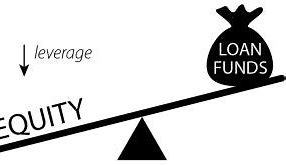
A leveraged loan is a high-risk loan for borrowers who have a lot of debt, bad credit, or both. Lenders usually charge higher rates of interest because the risk of default is higher. Businesses often use leverage.
Here's all you need to know about the leveraged loan, its pros, and cons, and how it works.
Definition and examples of leverage loans
Leveraged loans are given to borrowers with high debt levels and/or low credit ratings. Bank and non-bank lenders can provide leverage loans. Companies often use this type of loan to finance mergers, acquisitions, or leveraged acquisitions. Leverage loan plays an important role in the economy, allowing essential loans to less qualified borrowers.
There are no specific criteria for when a loan is leveraged, and no regulatory body has specifically defined what type of the loan constitutes a leveraged loan. Individual lenders set their own policy when a loan is considered leverage. Lenders generally consider the overall risk of each borrower, the cost of the loan, and the amount of debt the borrower has.
For example, a bank might give a low-leverage loan to a poorly rated corporate borrower with five times greater debt than its profits. Leverage loans can be used to finance the acquisition of another business.
According to an FDIC analysis by S&P Leveraged Commentary and Data, the leverage market was around $1.2 trillion in 2019.
How does a leverage loan work?
Individual financial institutions set their own criteria when a loan qualifies as a leveraged loan. Creditors analyze a borrower's overall risk based on their existing debt, credit rating, and other financial factors.
Most of the leveraged loans have higher interest rates than other types of financing. This is due to the additional risk that creditors take. Leveraged loans also usually have a variable interest rate. This implies that the interest rate can change over time, unlike fixed-rate loans, where the rate stays the same throughout the repayment period. Many leveraged loans have an interest rate tied to the London Interbank Offer Rate (LIBOR), which is based on banks' rates for overnight lending.
LIBOR is expected to be suspended after 2021. Banks may have to use a different benchmark rate for future leverage loans.
Some leveraged loans include "maintenance contracts." These clauses oblige borrowers to continue to meet certain criteria related to their financial performance in order not to break the loan agreement. Maintenance loans are considered less risky, but leveraged loans often no longer include these contracts.
Lenders often pass the risk of leverage loans on to investors. A growing number of banks are operating on an origin-to-distribute model in terms of leverage loans. This means that banks issue loans, but in reality, the loans are funded by secured loan bonds (asset-backed securities) or mutual funds. Investors may choose to buy funds for leveraged loans because the higher interest rate on these loans may provide higher returns and because the variable rate on these loans provides some protection against rising rates.
The Pros and Cons of Leveraged Loans
Companies can use leverage loans to finance mergers and acquisitions. They authorize loans even when the credit rating of the business is low. Leverage loan also allows lenders and investors to earn a higher interest rate, which can be more profitable.
However, borrowers face higher interest charges with leverage loans. These interest charges may increase over time for borrowers due to fluctuations in interest rates. Lenders also face a higher risk of borrower default as borrowers tend to have high debt and/or low credit scores. This means that the loan may not be repaid.
How do businesses use a leveraged loan?
Companies typically use leveraged loans to finance mergers and acquisitions (M&A), balance sheet recapitalization, debt refinancing, or general business purposes. Acquisitions and mergers can take the form of an LBO (leveraged buyout). An LBO occurs when a firm or private equity firm acquires a public entity and makes it private. Debt is generally used to finance part of the purchase price. Balance sheet recapitalization occurs when a company uses the capital market to change the makeup of its capital structure. A typical transaction issues debt to redeem shares or pay dividends, which are cash rewards paid to shareholders.
Leverage loans allow businesses or individuals who already have significant debt or bad credit history to borrow money, albeit at higher interest rates than normal.
Should You Get a Leveraged Loan?
Leveraged loans are popular with businesses. If you are a single borrower looking for a personal loan, you may be eligible for a different type of loan. Even if your credit score is not the best, you can still get a secured loan or a personal loan for bad credit. Having a home, a home equity line of credit, or a home equity loan can also be an option. Consider all loan options before you apply.
Summary
Bank and non-bank creditors can provide leveraged loans to borrowers with high debt and/or low credit ratings.
Leveraged loans are the most used by companies for leveraged mergers, leveraged buyouts, or acquisitions.
Leveraged loans usually have variable interest rates, which are tied to LIBOR (although LIBOR is expected to be suspended after 2021).
The interest rate on leveraged loans tends to be higher than the rate borrowers can get on other types of loans.
FOR MORE INFORMATION ON HOW UNIFIRST FINANCIAL & TAX CONSULTANTS CAN BEST HELP YOU WITH YOUR TAX FILING NEEDS, PLEASE CLICK THE BLUE TAB ON THIS PAGE.
THANKS FOR VISITING.
